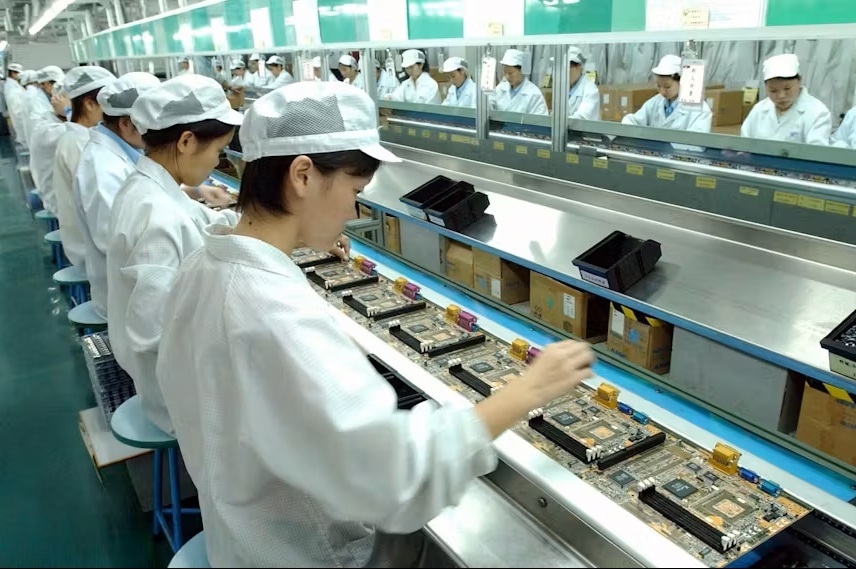China, Beginning of the End of Western Economic Dominance
TEHRAN (Defapress) - Over the past 2 decades, the relationship between the United States and China has shifted from economic cooperation to overt hostility, a transformation rooted in China’s profound economic and technological changes and their impact on the global capitalist order. At one time, China was considered an unparalleled source of cheap yet skilled and productive labor, forming a pillar of global supply chains.

Western companies like Apple made massive profits by exploiting the extremely low wages of Chinese workers, which in 2005 were less than one dollar per hour. But those days are over. Wages in China have now risen to over 8$ per hour, higher than any other developing country in Asia. This increase is the result of absorbing the labor force into a wage-based economy and the policies of the Chinese government under Xi Jinping, who has strengthened public services like healthcare and housing, thereby increasing workers’ bargaining power.
While this transformation is a valuable victory for Chinese workers, it poses a serious challenge for Western capitalists. Rising wages have reduced the profits of companies dependent on Chinese manufacturing and limited the ability of the Global North to exploit China through unequal trade. In the 1990s, China had to export massive volumes of goods to meet its import needs. Today, however, the export-to-import ratio has improved significantly, and less value is being transferred from China to the capitalist cores.
In response, the West faces 2 options: shift production to lower-wage regions like India, where labor costs about 2$ per hour, or attempt to suppress wages in China. The first option seems costly and risky due to supply chain disruptions and the need to rebuild infrastructure. The second option, however, has become the United States’ main strategy: weakening China’s economy through sanctions, economic warfare, and escalating military threats.
The Western claim that China manipulates global trade by artificially suppressing the yuan’s value is no longer consistent with reality. José Antonio Ocampo, an economist at the International Monetary Fund, pointed out in 2017 that China not only abandoned yuan suppression policies but has spent massive sums to prevent its devaluation.
China’s move to devalue the yuan in 2019 was also a response to the Trump administration's tariffs and had nothing to do with market manipulation. What is noteworthy is the West’s previous support for China through various loans during the low-yuan era up until 2010. But since the mid-2010s, when China raised wages and prices and shifted its role as the West’s cheap supplier, it began to face hostile behavior from Western governments.
However, the wage gap is only part of the story. In the past decade, China has made astonishing strides in advanced technologies through targeted industrial policies. Achievements such as the world’s largest high-speed rail network, production of commercial aircraft, leadership in renewable energy, significant progress in designing and manufacturing electric vehicles, medical technology, smartphones, microchips, and artificial intelligence are unprecedented for a country with a per capita income 80% lower than the average of developed nations.
These advances have jeopardized the West’s technological monopoly, which has kept Southern countries dependent on exporting cheap resources in exchange for access to essential technologies. Thus, by offering more affordable alternatives to developing nations, China has destabilized the foundations of the imperialist order.
In response, the U.S. imposed sanctions to cripple China’s technological development; yet these sanctions have not only failed but have further motivated China to pursue technological self-reliance. Now, given the current circumstances, the U.S. has resorted to military threats, not because China poses a military threat to the American people, but because China’s rise seriously endangers the economic interests of Western imperialist capitalism.
The West’s claims about China being a military threat are merely baseless propaganda. The data tells another story: China’s per capita military expenditure is lower than the global average and one-tenth that of the U.S. Even the U.S.-allied military bloc spends over seven times more than China on defense. In terms of nuclear warheads, the U.S. arsenal is eight times larger than China’s. China has only one overseas military base in Djibouti, whereas the U.S. has hundreds of bases across the globe, including near China’s borders. In the past 40 years, China has not engaged in a single war, while the U.S. has conducted military operations in more than 12 Global South countries.
Ultimately, the West’s hostility toward China has nothing to do with a military threat but stems from fear of losing economic dominance. Not because of a military threat, but due to fear of losing its economic dominance. Through its independent development, China has challenged the global order on which Western capitalism relies, an order built on cheap labor, cheap resources, and technological monopoly. This battle is not about security but about preserving economic supremacy, which the West is not willing to relinquish easily.
